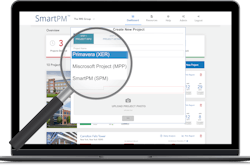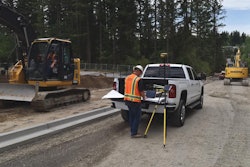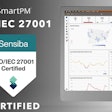
“Our subcontractor default insurance carrier has a vested interest in our planning and scheduling, because well-managed project schedules often reduce related claims,” explained Carolan, who supervises a team of 10 schedulers, both at the manager and project level. “So, they reviewed our scheduling practices and procedures near the end of 2020 to see how we stacked up.” Barton Malow Builders’ insurance carrier’s auditor used a platform called SmartPM, which is designed to analyze construction schedules. The platform leverages CPM scheduling software and data, giving construction executives and project teams insights to enhance schedule quality, assess risk, review past performance, forecast project completion, and control project outcomes.
The auditor ran a sample of Barton Malow Builders’ current and completed schedules through the software, uncovering a few challenged items.
“None of the metrics surprised anyone in the scheduling group,” Carolan offered. “We knew our schedules had areas that needed improvement, and SmartPM revealed them upon review.”
Neal Morton, Barton Malow Builders’ Vice President, Safety + Risk Management, declared that the most significant need for improvement was determining a more efficient way for non-schedulers to view a project’s scheduling information. Morton had participated in the audit and was impressed that SmartPM did just that, as it produced project metrics in a clear, easy-to-understand dashboard that eliminated Excel reports, complex analytics programs, and digging through the CPM scheduling database.
“We also noted how quickly the platform identified opportunities for improvement and potential delays,” said Carolan, whose team handles a diverse range of projects in markets including sports/entertainment, healthcare, education, commercial, and more. “After some technical discussions to understand the logistics of SmartPM, we started to believe it was something that could help us.”
Morton was even more convinced about SmartPM’s value. Consequently, Carolan and Morton agreed to implement SmartPM on all Barton Malow Builders’ projects; the aggressive one-year rollout proved to be extremely successful and led to a multi-year contract extension. In addition, Barton Malow Builders’ other operating entity (Barton Malow Company) and Barton Malow’s Education Team both saw the opportunity and similarly rolled out SmartPM across their projects.
The functionality of SmartPM is critical for the Schedulers, who are responsible for ensuring every project schedule employs industry best practices, meets company standards, and most importantly, proactively identifies and addresses schedule risk. This can be a daunting task, given that Barton Malow Builders often has over 70 active projects of varying size and complexity going on concurrently.
The truth is, an effective schedule analysis platform was identified and implemented years ago, but was not scalable in the long run.
“The previous schedule analysis platform was a bit less sophisticated,” noted Carolan. “Every Friday, we would pull all active schedules and run them through our analysis program. The subsequent reports had large volumes of analytics that were sent to project teams and executives.
“In smaller doses, for just a few offices, the process was satisfactory. But when we tried to scale it up to cover the entire company, the information often got diluted. Much of the target audience didn’t really understand what it was or what to do with it, so it didn’t have the impact we were looking for.”
The most significant deficiency was the timing of the update process. Schedules were pulled every Friday at the exact same time. But as virtually any construction professional can attest, maintaining such a rigid update schedule on a busy project is nearly impossible.
“When Friday came, many of the project updates hadn’t been completed yet, so the information we were analyzing was incomplete, leading to metrics and analysis that weren’t particularly useful for many projects. This was inefficient and caused challenges.”
However, with the addition of SmartPM, the project teams now inform scheduling when they have completed their updates and provide the appropriate files. As a result, the project teams can take an extra day or two to finish the update, as needed. As Carolan notes, “Nothing goes into SmartPM that isn’t fully updated for that month.”
The real-time project overview provided by the dashboard works extremely well, as executives and project teams can explore the dashboard at their convenience, when they’re ready to review the information. It’s not just another report that gets lost in the inbox.
“Our Vice President of Safety + Risk Management is a big proponent of the platform,” said Carolan. “He was running our planning group at the time, and he told us how he had never been able to have all the schedules for our entire company in front of him, where now he can quickly analyze everything going on. SmartPM gives him the ability to do that.”
Carolan pointed out the importance of seeing a metric-like compression, which had never been a part of the weekly reporting in the past.
“Figuring compression is a time-consuming process, and we usually only do it if there was a specific claim. The fact that it’s automatically in there now is a major plus for us. You can’t fool that metric. If the project team does an update and the forecasted completion timeline doesn’t make sense relative to the productivity so far, the compression metric will throw warning flags up.
“We know there are always things that can throw a project off schedule. It’s easy to make changes to the schedule in a software that will show you how you can get back on plan.”
According to Carolan, SmartPM can quickly recognize when a schedule is overly optimistic, much earlier than manual reviews; when that happens, he can communicate to his teams that they need to reexamine the scheduled path to completion and adjust accordingly. Perhaps additional resources can be assigned to a specific task (i.e., an electrical subcontractor has two crews but based on the SmartPM analysis, they might need three).
“SmartPM creates a positive feedback loop,” he explained. “When our team sees improved scores, they are more apt to trust the metrics that are being produced. This not only leads to better outcomes, but it also spurs more productive discussions and better maintenance of the schedule.
“That trust carries over to the next schedule and continues to build. Members of both the scheduling and project teams are asking more questions and looking for more information about their schedules. We take that as a very good sign.”
Measurable results are difficult to ascertain because, as Carolan points out, “It’s hard to quantify something that didn’t happen. When SmartPM raises red flags on a project, we take fast, corrective action. If we didn’t, what would have happened? There would be a greater chance that the project has scheduling delays, which would lead to increased cost.”
Carolan stated with certainty that creating operational scheduling transparency can identify risks sooner, which is a benefit to owners, subcontractors, and project teams.
“Some metrics we looked at in the past were lagging indicators – that is, by the time we saw them, it was often too late to mitigate the problems. SmartPM provides leading indicators that give us time to adjust early and with more confidence.
“We worked on a hospital facility recently for which SmartPM provided an indicator 12 months from substantial completion, showing that substantial completion would be late,” Carolan recalled. “It didn’t look like we could finish in that timeframe unless we shifted select items forward. We made certain significant modifications that flattened out the curve considerably.”
For Carolan, the information generated from the SmartPM program is invaluable. But there’s a larger benefit here that cannot be overlooked.
“SmartPM helps create more time to consume the schedule, in lieu of focusing on the process to produce the schedule,” he concluded. “It refocuses our energy on what’s needed. This leaves us plenty of time to address and fix issues.”
For Carolan, that means keeping projects on track and substantially mitigating the inevitable risks that can always be there. With SmartPM, he is accomplishing both of these objectives every day.















